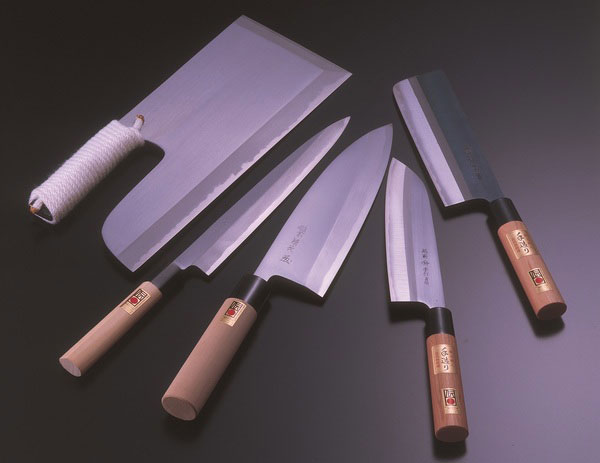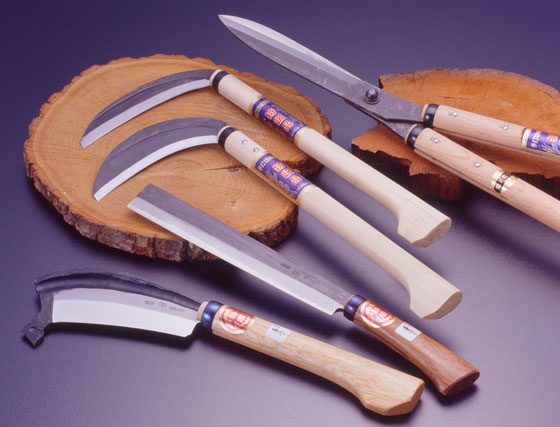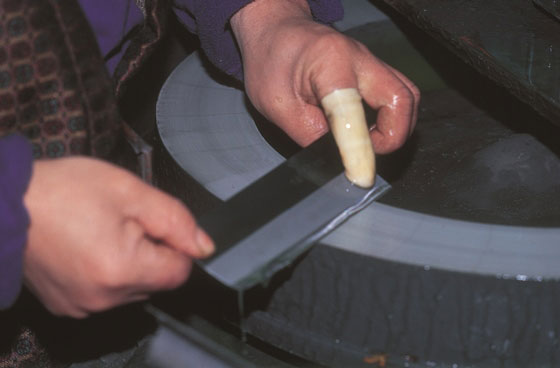
- Metal works
- Fukui
Echizen cutlery Echizen uchihamono
Years of practice and the artisans' skills
make a thin and light blade forged by unique techniques
Description
What is Echizen cutlery ?
Echizen cutlery (called Echizen uchihamono in Japanese) is produced around the city of Echizen, Fukui prefecture. A double layering technique is used for knives and a rotated steel joining technique for sickles.
Double layering is a forging method where two blade plates are layered and hammer beaten on both sides. Since the thickness of the blade is doubled by layering, a lot of forceful hammer beating is needed to effectively stretch and thin the knife blade. In addition, double layering prevents any drops in temperature while heating. This removes the need for repeated heating and results in less unevenness on the blade surface.
The rotated steel joining technique involves beating steel into a diamond shaped blade edge by starting from the corner across the whole blade. This technique results in a thin, sturdy, and easily-sharpened sickle blade which stays sharp for a long time.
History

The origin of Echizen cutlery is said to date back to the first half of the 14th century when CHIYOZURU Kuniyasu, a swordsmith in Kyoto, relocated to the Echizen area. He crafted swords along with sickles for the farmers in the area, which has been known for its agricultural tool production ever since.
During the Edo period (1603-1868), a blacksmiths merchant guild was organized under the patronage of the Sendai domain (present day Miyagi prefecture). In addition, collectors of Japanese lacquerware, familiar with the quality of the blades, sold hammer-forged sickles to supplement their income and took orders for blades from all over the country, as they had been traveling far and wide looking for lacquer trees. When the Meiji period (1868-1912) started, the merchant guild lost the backing of the Sendai domain and was dissolved. This did not slow growth as in 1874, Echizen sickles still accounted for nearly thirty percent of national production and knives for about twenty-five percent. Until the Showa period (1926-1989), the development of the silk industry increased the demand for mulberry cutting sickles and knives which ensured the stability of the Echizen cutlery industry.
Over the generations, Echizen cutlery artisans have maintained traditional hand-finishing techniques and produce a range of quality products, mainly knives, sickles, billhooks, and trimming shears.
General Production Process

- 1. Preparing the steel
The steel of the cutting edge is heated at about 800℃ (about 1472℉) and forged to the required size. Forging is when metal is shaped and strenghthened by beating with a hammer.
- 2. Forge welding
A bar of iron has a groove cut in one side. The steel blade is inserted and beaten with a hammer to join the blade and iron together.
- 3. Shaping the knife
The flat part of the knife is shaped and cut to size.
- 4. Making the tang
The tang of the knife for attaching the handle is forged.
- 5. Double layering
The blade is evenly thinned by stretching the two layered plates through beating both sides with a high-speed machine hammer. Since the thickness of blades has been doubled from layering, the hammer is an effective tool for the step. Double layering keeps the temperature of the metal stable, which means no need for repeated heating. This is good because heating the metal too much adds unevenness to the blade surface. Double stretching is a technique that is unique to this craft.
- 6. Annealing
After the blade is heated to a temperature of about 800℃ (about 1472℉), it is left to naturally cool in order to stabilize the metal structure.
- 7. Rough smoothing
The surface of the blade is smoothed with a high-speed machine hammer and any matter stuck to the blade is removed.
- 8. Finish smoothing
The blade is stretched out through beating with a hammer.
- 9. Cutting to the shape
The blade is cut according to the desired shape and excess metal is trimmed.
- 10. Hardening
After the blade is coated with mud and heated at a temperature of about 800℃ (1472℉), it is quickly plunged in cold water for cooling. This process hardens the steel.
- 11. Tempering
To give the steel durability, the blade is heated at a temperature of 150 to 220℃ (302 to 428℉) for about thirty minutes and slowly cooled to room temperature. Hard steel is brittle and broken easily, but tempering makes the blade durable.
- 12. Rough sharpening
After the rough blade shape is ground on a coarse grain whetstone, the edge of the blade is sharpened across with a fine grain whetstone.
- 13. Blade sharpening
The edge of the blade is sharpened carefully.
- 14. Finish sharpening
After the whole knife is polished until shiny, the sharpened part is dulled with a blurring machine. The blade is finished after making a slight gap on the edge of the blade to prevent loss of sharpness.
Where to Buy & More Information
Fukui Ceramics Center
-
Address
-
Tel.+81-776-41-3611
-
ClosedAround the New Year
-
Business Hours9am to 5pm
-
Website
See more Metal works
- Nambu ironware
- Takaoka copperware
- Yamagata cast iron
- Sakai cutlery
- Tokyo silverware
- Echizen cutlery
- Osaka naniwa pewterware
- Tosa cutlery
- Tsubame-tsuiki copperware
- Shinshu Forged Blades
- Banshu-miki cutlery
- Higo inlays
- Echigo-sanjo cutlery
- Echigo-yoita cutlery
- Chiba Artisan Tools
- Tokyo antimony craft































































































































































































































































































